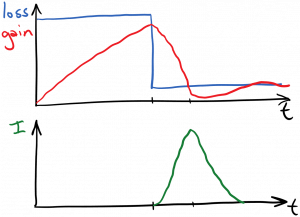Another method of obtaining short, high intensity pulsed output from a laser is Q switching, which I will describe here. As you know, for a lasing optical mode, the round-trip gain is clamped equal to the round-trip loss in steady state above threshold. But we can create a transient situation where the gain is much greater than the loss for a short time, resulting in a short, intense pulse of light. In order to make the light as intense as possible, we want to make the gain as high as possible. We accomplish this by first setting the round-trip loss very high (cavity Q very low). This allows us to pump the gain to a very high level without it clamping. Once the gain has reached a high level, we abruptly lower the round-trip loss (raise the cavity Q). This is called Q switching, and it creates a situation in which the round trip gain is much greater than the round trip loss immediately after switching. This situation isn’t sustainable, of course. The photon number climbs rapidly, as does the stimulated emission rate. The increased stimulated emission rate drives the inversion and the gain back down below the loss. But the entire process does yield a short, intense pulse of light. The process is diagrammed below.

The key to this process is being able to Q-switch the cavity – in other words, to have an optical cavity whose Q has a small value, but can be switched so that the Q value becomes very high. One simple trick here is to rotate one of the cavity mirrors so that it no longer faces the other mirror. This eliminates reflections from the rotated mirror for light propagating along the cavity axis, thus making the cavity Q very low (high loss). To switch the Q, we simply rotate the mirror back so that it faces the other mirror. Assuming a high-quality mirror, this will make the cavity Q very high (low loss). In addition, we could also use some of the same tricks we used for modelocking, such as acousto-optic modulators, etc.
One useful analogy to a Q-switched laser is a capacitor. We can store electrical charge on a capacitor, which can then be converted to a pulse of current by connecting the capacitor to a circuit (discharging the capacitor). Similarly, we can store energy in the form of excited atoms in a low-Q laser cavity, which we can then ‘discharge’ by raising the cavity Q, converting the energy in the excited atoms into a pulse of photons.


You must be logged in to post a comment.